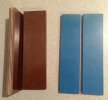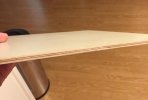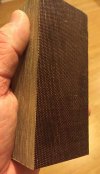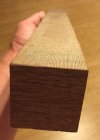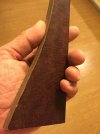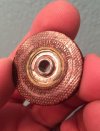- Joined
- Oct 17, 2010
- Messages
- 2,424
Hey guys, wanted to start a thread discussing some of these old phenolics, which I know have been talked about in the past, but I'm only just now starting to educate myself. Don Hanson's recent "Butterscotch" micarta forays, got me interested in the material. I've used some "Antique Ivory" westinghouse stuff not too long ago, that I acquired from Alpha I think at Blade a couple of years ago, but thus far that's all I've played with.
I'm making a lot of slipjoints these days, and for whatever reason, I just don't care for wood on them. Fossil ivory pickings have been slim the last couple years, probably only going to get slimmer, although I use it, pearl, or stag for most knives. All of these supplies are dwindling. Jigged bone is a good alternative I guess, although I haven't settled on what I like. The other option, is phenolics, but of course, it's gotta be rare and different. Right?
I tracked down Don's source for the Butterscotch (thanks John!), got some otw. I also found some expensive, but I believe genuine gorgeous blue Westinghouse Ivorite, and I just ordered some more of what I believed to be Westinghouse ivory paper micarta, but it's really a tan/beige color as opposed to the white with yellowed skin, that I'm used to. It actually looks just like the Ivorite in "texture". It's definitely not the standard "paper" micarta that's available. I'm wondering if it's from "unbleached" paper micarta, which I know westinghouse produced at one point. Anybody have any info they'd like to share? Input on the genuineness of this stuff? (Will post a pic if requested). I put in some request for info from the seller, to see if they have photos of any tags or labels, etc. The guy I got the blue Ivorite, does have legit westinghouse labels on the original stock.
I also picked up some old canvas micarta from Ray Kirk (you out there Ray?) at Tannehill this year, it's incredibly dense stuff, that looks different from what's available these days also.
What else is out there? Who's got sources? Who has some info or history on this stuff?
I'm making a lot of slipjoints these days, and for whatever reason, I just don't care for wood on them. Fossil ivory pickings have been slim the last couple years, probably only going to get slimmer, although I use it, pearl, or stag for most knives. All of these supplies are dwindling. Jigged bone is a good alternative I guess, although I haven't settled on what I like. The other option, is phenolics, but of course, it's gotta be rare and different. Right?
I tracked down Don's source for the Butterscotch (thanks John!), got some otw. I also found some expensive, but I believe genuine gorgeous blue Westinghouse Ivorite, and I just ordered some more of what I believed to be Westinghouse ivory paper micarta, but it's really a tan/beige color as opposed to the white with yellowed skin, that I'm used to. It actually looks just like the Ivorite in "texture". It's definitely not the standard "paper" micarta that's available. I'm wondering if it's from "unbleached" paper micarta, which I know westinghouse produced at one point. Anybody have any info they'd like to share? Input on the genuineness of this stuff? (Will post a pic if requested). I put in some request for info from the seller, to see if they have photos of any tags or labels, etc. The guy I got the blue Ivorite, does have legit westinghouse labels on the original stock.
I also picked up some old canvas micarta from Ray Kirk (you out there Ray?) at Tannehill this year, it's incredibly dense stuff, that looks different from what's available these days also.
What else is out there? Who's got sources? Who has some info or history on this stuff?


